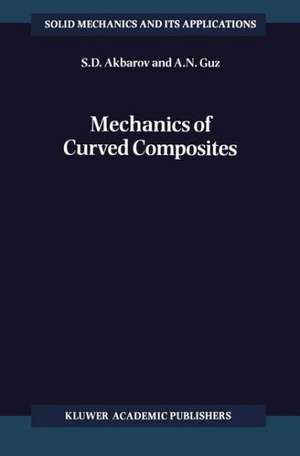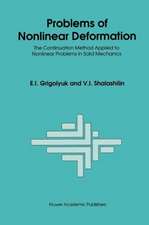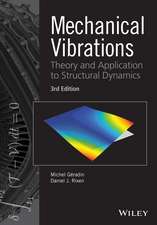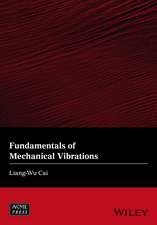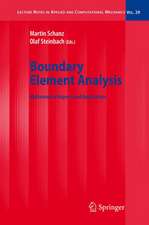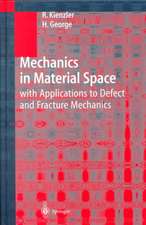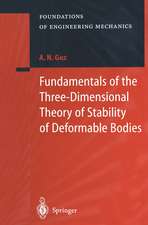Mechanics of Curved Composites: Solid Mechanics and Its Applications, cartea 78
Autor S.D. Akbarov, A. N. Guzen Limba Engleză Paperback – 30 noi 2001
Din seria Solid Mechanics and Its Applications
- 20%
 Preț: 698.10 lei
Preț: 698.10 lei - 24%
 Preț: 800.16 lei
Preț: 800.16 lei -
 Preț: 402.14 lei
Preț: 402.14 lei - 15%
 Preț: 640.06 lei
Preț: 640.06 lei - 15%
 Preț: 653.14 lei
Preț: 653.14 lei - 18%
 Preț: 1124.92 lei
Preț: 1124.92 lei - 15%
 Preț: 643.84 lei
Preț: 643.84 lei - 18%
 Preț: 1119.38 lei
Preț: 1119.38 lei - 20%
 Preț: 573.20 lei
Preț: 573.20 lei - 18%
 Preț: 1607.92 lei
Preț: 1607.92 lei - 17%
 Preț: 393.72 lei
Preț: 393.72 lei - 17%
 Preț: 459.41 lei
Preț: 459.41 lei - 18%
 Preț: 959.98 lei
Preț: 959.98 lei - 18%
 Preț: 747.71 lei
Preț: 747.71 lei -
 Preț: 388.55 lei
Preț: 388.55 lei - 18%
 Preț: 787.15 lei
Preț: 787.15 lei -
 Preț: 406.25 lei
Preț: 406.25 lei - 15%
 Preț: 639.08 lei
Preț: 639.08 lei - 24%
 Preț: 784.84 lei
Preț: 784.84 lei - 15%
 Preț: 643.34 lei
Preț: 643.34 lei - 18%
 Preț: 958.07 lei
Preț: 958.07 lei - 18%
 Preț: 1228.15 lei
Preț: 1228.15 lei - 18%
 Preț: 734.27 lei
Preț: 734.27 lei - 18%
 Preț: 1233.06 lei
Preț: 1233.06 lei - 18%
 Preț: 1236.19 lei
Preț: 1236.19 lei - 18%
 Preț: 950.96 lei
Preț: 950.96 lei - 18%
 Preț: 906.48 lei
Preț: 906.48 lei - 18%
 Preț: 964.54 lei
Preț: 964.54 lei - 20%
 Preț: 995.75 lei
Preț: 995.75 lei - 18%
 Preț: 953.65 lei
Preț: 953.65 lei - 18%
 Preț: 1239.67 lei
Preț: 1239.67 lei - 18%
 Preț: 962.35 lei
Preț: 962.35 lei - 18%
 Preț: 964.54 lei
Preț: 964.54 lei - 18%
 Preț: 913.11 lei
Preț: 913.11 lei - 18%
 Preț: 1226.90 lei
Preț: 1226.90 lei
Preț: 573.77 lei
Preț vechi: 717.21 lei
-20% Nou
Puncte Express: 861
Preț estimativ în valută:
109.79€ • 117.40$ • 91.54£
109.79€ • 117.40$ • 91.54£
Carte tipărită la comandă
Livrare economică 14-21 aprilie
Preluare comenzi: 021 569.72.76
Specificații
ISBN-13: 9781402003837
ISBN-10: 1402003838
Pagini: 468
Ilustrații: XVI, 448 p.
Dimensiuni: 155 x 235 x 25 mm
Greutate: 0.63 kg
Ediția:Softcover reprint of the original 1st ed. 2000
Editura: SPRINGER NETHERLANDS
Colecția Springer
Seria Solid Mechanics and Its Applications
Locul publicării:Dordrecht, Netherlands
ISBN-10: 1402003838
Pagini: 468
Ilustrații: XVI, 448 p.
Dimensiuni: 155 x 235 x 25 mm
Greutate: 0.63 kg
Ediția:Softcover reprint of the original 1st ed. 2000
Editura: SPRINGER NETHERLANDS
Colecția Springer
Seria Solid Mechanics and Its Applications
Locul publicării:Dordrecht, Netherlands
Public țintă
ResearchCuprins
1.1. Types of composite materials.- 1.2. Specific curving of reinforcing elements.- 1.3. Background and brief review.- 1. Plane-curved Composites.- 1.1. Classical theories.- 1.2. Basic equations and boundary conditions.- 1.3. Constitutive relations.- 1.4. Displacement equations; formulation and solution.- 1.5. Example for exact solution.- 1.6. Vibration problems.- 1.7. Quasi-homogeneous stress states corresponding to pure shears.- 1.8. Quasi-homogeneous states corresponding to tension-compression.- 1.9. Some detailed results on quasi-homogeneous states.- 1.10. Composites with large-scale curving.- 1.11. Bibliographical notes.- 2. General curved composites.- 2.1. Some preliminary remarks on geometry.- 2.2. Constitutive relations.- 2.3. Explicit constitutive relations for small curving.- 2.4. Displacements equations for small curving; formulation and solution.- 2.5. Example of the small parameter method.- 2.6. An exact solution.- 2.7. Pure shear of composite materials.- 2.8. Quasi-homogeneous stress state corresponding to triaxial tension-compression.- 2.9. Approximate results for layered composites.- 2.10. The applicability of the proposed approach.- 2.11. Bibliographical notes.- 3. Problems for curved composites.- 3.1. Bending of a strip.- 3.2. Bending of a rectangular plate.- 3.3. Vibration problems.- 3.4. Bibliographical notes.- 4. Plane-strain state in periodically curved composites.- 4.1. Formulation.- 4.2. Method of solution.- 4.3. Stress distribution in composites with alternating layers.- 4.4. Stress distribution in composites with partially curved layers.- 4.5. Viscoelastic composites.- 4.6. Stress distribution in composites with viscoelastic layers.- 4.7. Composite materials with anisotropic layers.- 4.8. Numerical results: rectilinear anisotropy.- 4.9. Numerical results: curvilinear anisotropy.- 4.10. Bibliographical notes.- 5. Composites with spatially periodic curved layers.- 5.1. Formulation.- 5.2. The equation of contact surfaces.- 5.3. The presentation of the governing relations in series form.- 5.4. Method of solution.- 5.5. Stress distribution.- 5.6. Bibliographical notes.- 6. Locally-curved composites.- 6.1. Formulation.- 6.2. Method of solution.- 6.3. Composite with alternating layers.- 6.4. The influence of local curving form.- 6.5. Bibliographical notes.- 7. Fibrous composites.- 7.1. Formulation.- 7.2. Method of solution for lower fiber concentration.- 7.3. Method of solution for higher fiber concentrations.- 7.4. Numerical results.- 7.5. Screwed fibers in an elastic matrix.- 7.6. Bibliographical notes.- 8. Geometrically non-linear problems.- 8.1. Formulation. Governing relations and equations.- 8.2. Method of solution.- 8.3. Numerical results.- 8.4. Bibliographical notes.- 9. Normalized modulus elasticity.- 9.1. Basic equations.- 9.2. Normalized moduli.- 9.3. Numerical results.- 9.4. Bibliographical notes.- 10. Fracture problems.- 10.1. Fiber separation.- 10.2. Crack problems.- 10.3. Fracture in compression.- 10.4. Bibliographical notes.- Supplement 1. Viscoelastic unidirectional composites in compression.- 5.1.1. Fracture of unidirectional viscoelastic composites in compression.- 5.1.2. Compressive strength in compression of viscoelastic unidirectional composites.- 5.1.3. Bibliographical notes.- Supplement 2. Geometrical non-linear and stability problems.- 5.2.1. Geometrical non-linear bending of the strip.- 5.2.2. Stability loss of the strip.- 5.2.3. Bibliographical notes.- References.- References Supplement.
